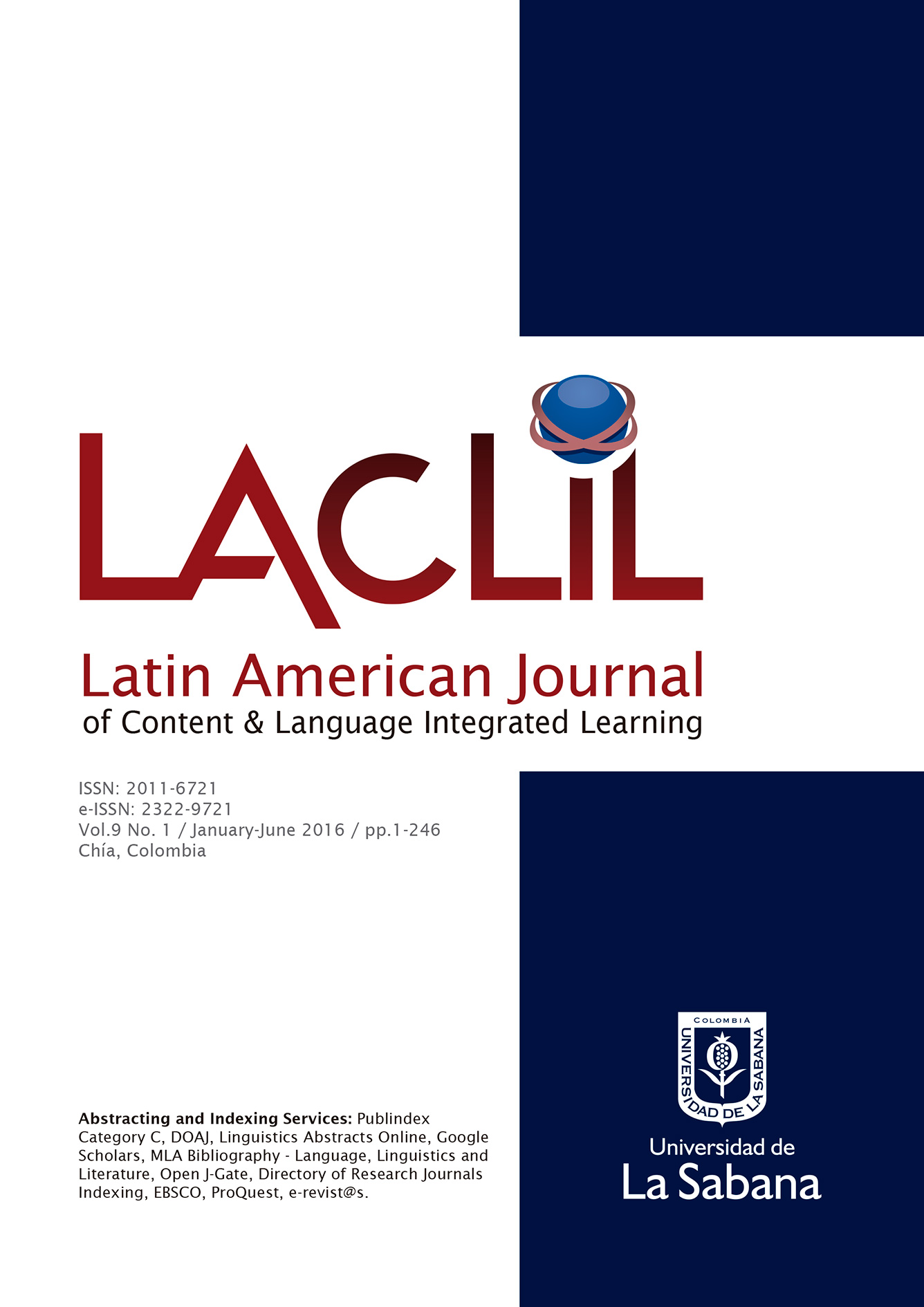Uso de traductores en línea en la clase de una segunda lengua: ideas para español de nivel avanzado
DOI:
https://doi.org/10.5294/6007Palabras clave:
traductores en línea, edición de resultados del traductor en línea, aprendizaje de español a nivel avanzado, conciencia metalingüística, aprendizaje de cláusulas subordinadas en españolResumen
En este artículo se discuten los beneficios de utilizar traductores en línea en la clase de lengua extranjera. Específicamente, se describe cómo se pueden utilizar resultados incorrectos del traductor en línea para crear actividades que ayuden a crear conciencia metalingüística sobre la gramática de la segunda lengua y las diferencias entre las construcciones gramaticales entre la primera y la segunda lengua, lo cual puede ser de ayuda en el proceso de aprendizaje. Se explican estructuras específicas del español de nivel avanzado que producen resultados incorrectos en el traductor; posteriormente, se suministran muestras de actividades de edición para estas estructuras, así como evidencia anecdótica relacionada con la reacción de los estudiantes ante estas tareas. Aun cuando las actividades presentadas están diseñadas específicamente para español, también pueden ser utilizadas como modelo para otras lenguas. Cabe anotar que estas actividades podrían ser útiles para profesores de español, ya que estas estructuras se cubren en muchos cursos de gramática del español a nivel avanzado. Igualmente, estas actividades podrían ser de utilidad para estudiantes interesados en trabajos relacionados con traducción.Descargas
Citas
Alderson, J. C., Clapham, C., & Steel, D. (1997). Metalinguistic knowledge, language aptitude and language proficiency. Language Teaching Research, 1(2), 93-121.
Alipour, S. (2014). Metalinguistic and linguistic knowledge in foreign language learners. Theory and Practice in Language Studies, 4(12), 2640-2645.
Berg, E. C. (1999). The effects of trained peer response on ESL students’ revision types and writing quality. Journal of Second Language Writing, 8(3), 215-241.
Bialystok, E. (1979). Explicit and implicit judgements of L2 grammaticality of L2 grammaticality. Language Learning, 29(1), 81-103.
Bialystok, E. (1981). The role of linguistic knowledge in second language use. Studies in Second Language Acquisition, 4(1), 31-45.
Burton, C. (2003). Idea: The online translator: Implementing national standard 4.1. Hispania, 86(2), 320-321.
Butt, J., & Carmen, B. (2004). A new reference grammar of modern Spanish. New York, NY: McGraw-Hill.
Byrd, D. R. (2003). Practical tips for implementing peer editing tasks in the foreign language classroom. Foreign Language Annals, 36(3), 434-441.
Campos, H. (1993). De la oración simple a la oración compuesta. Washington, DC: Georgetown University Press.
Correa, M. (2011). Subjunctive accuracy and metalinguistic knowledge of L2 learners of Spanish. Electronic Journal of Foreign Language Teaching, 8(1), 39-56.
Correa, M. (2014). Leaving the “peer” out of peer-editing: Online translators as a pedagogical tool in the Spanish as a second language classroom. Latin American Journal of Content and Language Integrated Learning, 7(1), 1-20.
French, J. R. (1991). Machine translation. In W. Brierley & I. R. Kemble (Eds.), Computers as a tool in language teaching (pp. 55-69). Chichester, West Sussex: Ellis Horwood Limited.
Garcia, I., & Pena, M. I. (2011). Machine translation-assisted language learning: writing for beginners. Computer Assisted Language Learning, 24(5), 471-487.
Hansen, J. G., & Liu, J. (2005). Guiding principles for effective peer response. ELT Journal, 59(1), 31-38.
Kliffer, M. D. (2005). An experiment in MT post-editing by a class of intermediate/advanced French majors. In Proceedings of EAMT, 10th Annual Conference (pp. 160-165).
Budapest, Hungary.
Koike, D. A., & Klee, C. A. Lingüística aplicada: Adquisición del español como segunda lengua. New York, NY: Wiley.
Larousse. (Eds.). (2010). Gramática lengua española: Reglas y ejercicios. México, DF: Larousse México.
Lundstrom, K., & Baker, W. (2009). To give is better than to receive: The benefits of peer review to the reviewer’s own writing. Journal of Second Language Writing, 18(1), 30-43.
Lunn, P. V., & DeCesaris, J. A. (2006). Investigación de gramática. Boston, MA: Heinle Cengage Learning.
Luton, L. (2003). If the computer did my homework, how come I didn’t get an “A”? The French Review, 76(4), 766-770.
National Standards in Foreign Language Education Project. (2015). World-readiness standards for learning languages. Alexandria, VA: Author.
Niño, A. (2008). Evaluating the use of machine translation post-editing in the foreign language class. Computer Assisted Language Learning, 21(1), 29-49.
Niño, A. (2009). Machine translation in foreign language learning: Language learners’ and tutors’ perceptions of its advantages and disadvantages. ReCALL, 21(2), 241-258.
O’Neill, E. M. (2012). The effect of online translators on L2 writing in French (Unpublished doctoral dissertation). University of Illinois at Urbana-Champaign, Urbana, IL.
Renou, J. (2001). An examination of the relationship between metalinguistic awareness and second-language proficiency of adult learners of French. Language Awareness, 10(4), 248-267.
Richmond, I. M. (1994). Doing it backwards: Using translation software to teach target-language grammaticality. Computer Assisted Language Learning, 7(1), 65-78.
Roehr, K. (2007). Metalinguistic knowledge and language ability in university-level L2 learners. Applied Linguistics, 29(2), 173-199.
Shei, C.-C. (2002). Teaching MT through pre-editing: Three case studies. In Proceedings of the 6th EAMT Workshop Teaching Machine Translation (pp. 89-98). Manchester, UK:
EAMT.
Somers, H. (2003). Machine translation in the classroom. In H. Somers (Ed.), Computers and translation. A translator’s guide (pp. 319-340). Amsterdam/Philadelphia: Benjamins.
Whitley, M. S., & González, L. (2007). Gramática para la composición. Washington, DC: Georgetown University Press.
Williams, L. (2006). Web-based machine translation as a tool for promoting electronic literacy and language awareness. Foreign Language Annals, 39(4), 565-578.
Descargas
Publicado
Cómo citar
Número
Sección
Licencia
Los autores que publican en esta revista están de acuerdo con los siguientes términos:
Esta revista y sus artículos se publican bajo la licencia Creative Commons Atribución-NoComercial-SinDerivadas 4.0 Internacional (CC BY-NC-ND 4.0), por lo cual el usuario es libre de: compartir, copiar y redistribuir el material en cualquier medio o formato, siempre y cuando: dé crédito de manera adecuada, brinde un enlace a la licencia e indique si se han realizado cambios; no use nuestro contenido con propósitos comerciales; y/o remezcle o transforme el material. Recuerde que no tiene los permisos para distribuir el material si fue modificado.








